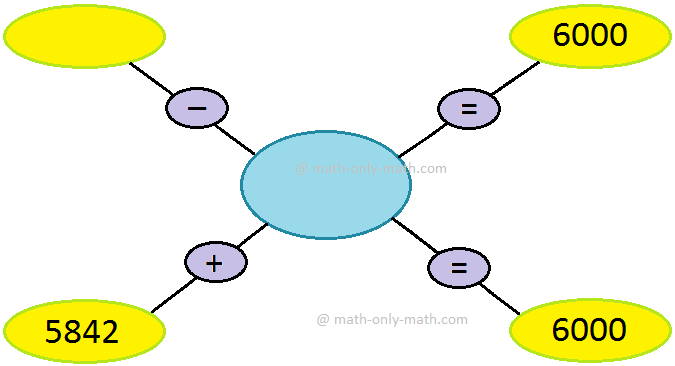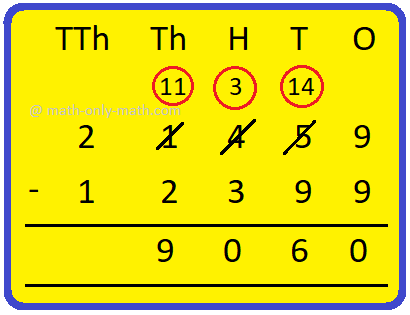Problems on Compound Angles
We will learn how to solve different types of problems on compound angles using formula.
We will see step-by-step how to deal with the trigonometrical ratios of compound angles in different questions.
1. An angle θ is divided into two parts so that the ratio of the tangents of the parts is k; if the difference between the parts be ф, prove that, sin ф = (k - 1)/(k + 1) sin θ .
Solution:
Let, α and β be the two parts of the angle θ.
Therefore, θ = α + β.
By question, θ = α - β. (assuming a >β)
and tan α/tan β = k
⇒ sin α cos β/sin β cos α = k/1
⇒ (sin α cos β + cos α sin β)/(sin α cos β - cos α sin β) = (k + 1)/(k - 1), [by componendo and dividendo]
⇒ sin (α + β)/sin (α - β) = (k + 1)/(k - 1)
⇒ (k + 1) sin Ø = (k - 1) sin θ, [Since we know that α + β = θ; α + β = ф]
⇒ sin ф = (k - 1)/(k + 1) sin θ. Proved.
2. If x + y = z and
tan x = k tan y, then prove that sin (x - y) = [(k - 1)/(k + 1)] sin z
Solution:
Given tan x = k tan y
⇒ sin x/cos x = k ∙ sin y/cos y
⇒ sin x cos y/cos x sin y = k/1
Applying componendo and dividend, we get
sin x cos y + cos x sin y/ sin x cos y - cos x sin y = k + 1/k - 1
⇒ sin (x + y)/sin (x – y) = k + 1/k - 1
⇒ sin z/sin (x – y) = k + 1/k - 1, [Since x + y = z given]
⇒ sin (x – y) = [k + 1/k – 1] sin z Proved.
3. If A + B + C = π and cos A = cos B cos C, show that, tan B tan C = 2
Solution:
A + B + C = π
Therefore, B + C = π - A
⇒ cos (B + C) = cos (π - A)
⇒ cos B cos C - sin B sin C = - cos A
⇒ cos B cos C + cos B cos C = sin B sin C,[Since we know, cos A = cos B cos C]
⇒ 2 cos B cos C = sin B sin C
⇒ tan B tan C = 2 Proved.
Note: In different problems on compound angles we need to use the formula as required.
4. Prove that cot 2x + tan x = csc 2x
Solution:
L.H.S. = cot 2x + tan x
= cos 2x/sin 2x + sin x/cos x
= cos 2x cos x + sin 2x sin x/sin 2x cos x
= cos (2x - x)/sin 2x cos x
= cos x/sin 2x cos x
= 1/sin 2x
= csc 2x = R.H.S. Proved.
5. If sin (A + B) + sin (B + C) + cos (C - A) = -3/2 show that,
sin A + cos B + sin C = 0; cos A + sin B + cos C = 0.
Solution:
Since, sin (A + B) + sin (B + C) + cos (C - A) = -3/2
Therefore, 2 (sin A cos B + cos A sin B + sin B cos C + cos B sin C + cos C cos A + sin C sin A) = -3
⇒ 2 (sin A cos B + cos A sin B + sin B cos C + cos B sin C + cos C cos A + sin C sin A) = - (1 + 1 + 1)
⇒ 2 (sin A cos B + cos A sin B + sin B cos C + cos B sin C + cos C cos A + sin C sin A) = - [(sin^2 A + cos^2 A) + (sin^2 B + cos^2 B) + (sin^2 C + cos^2 C)]
⇒ (sin^2 A + cos^2 B + sin^2 C + 2 sin A sin C + 2 sin A cos B + 2 cos B sin C) + (cos^2 A + sin^2 B + cos^2 C + 2 cos A sin B + 2 sin B cos C + 2 cos A cos C) = 0
⇒ (sin A + sin B + sin C)^2 + (cos A + sin B + cos C)^2
Now the sum of squares of two real quantities is zero if each quantity is separately zero.
Therefore, sin A + cos B + Sin C = 0
and cos A + sin B + cos C = 0. Proved.
11 and 12 Grade Math
From Problems on Compound Angles to HOME PAGE
Didn't find what you were looking for? Or want to know more information about Math Only Math. Use this Google Search to find what you need.
Recent Articles
-
Multiplication Table | Learn Tables from 0 – 25 | Multiplication Table
Jan 14, 25 11:09 PM
In math multiplication table we will learn the tables from 0 – 25. These multiplication tables help the students to learn the essential multiplication facts. Multiplication tables are very important f… -
3rd Grade Math Worksheets |3rd Grade Math Sheets|3rd Grade Math Lesson
Jan 14, 25 11:02 PM
3rd grade math worksheets is carefully planned and thoughtfully presented on mathematics for the students. Teachers and parents can also follow the worksheets to guide the students. -
3rd Grade Subtraction Worksheet | 3-Digit Subtraction Worksheets | Ans
Jan 14, 25 01:57 PM
In 3th Grade Addition Worksheet we will solve how to subtract 3-digit numbers by expansion, subtraction of 3-digit numbers without regrouping, subtraction of 3-digit numbers with regrouping, propertie… -
Facts about Subtraction | Subtraction of Small Numbers|Solved Examples
Jan 14, 25 12:29 AM
The operation to finding the difference between two numbers is called subtraction. Let us know some facts about subtraction which will help us to learn subtraction of large numbers. 1. Subtraction wit… -
Word Problems on Subtraction |Worksheet on Subtraction Word Problems |
Jan 14, 25 12:21 AM
In word problems on subtraction we need to read the question carefully and understand what we need to find out. We know, in subtraction the larger number from which we subtract the other number (the s…





New! Comments
Have your say about what you just read! Leave me a comment in the box below. Ask a Question or Answer a Question.